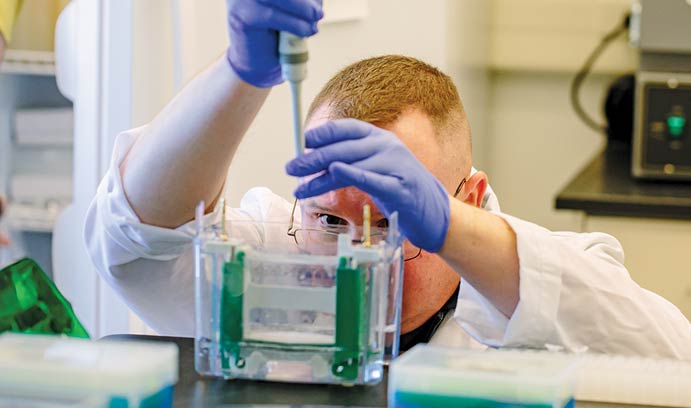A New Tool to Fight Drug-Resistant Bacteria

In the search for alternatives to antibiotics, researchers seek to disrupt the delivery of virulence factors to healthy cells.
Bacteria cause infections by delivering toxins to healthy cells. One way they accomplish this is by releasing vesicles that act as tiny envelopes transporting toxins to host cells. These toxins allow the bacteria to make themselves at home in cells.
In the search for alternatives to antibiotics, researchers are exploring untraditional infection treatments that target these virulence factors.
"Instead of killing bacteria," says Angela Brown, assistant professor of chemical and biomolecular engineering, "we make them really uncomfortable, giving the immune system time to mount a strong response."
Brown is pioneering a unique approach that, unlike previous methods of targeting virulence factors, has the potential to apply to a broad range of pathogens. She and her team are studying the outer membrane vesicles regularly shed by Gram-negative bacteria, which cause infections in hospitals and other health care settings and are increasingly resistant to antibiotics. The researchers are seeking to identify delivery mechanisms common among Gram-negative bacteria and then to develop broad-range antibacterial molecules that radically change the way physicians fight bacteria.
The National Science Foundation recently awarded Brown a five-year, $500,000 CAREER Award to pursue her research.
The need for new antibiotic strategies is urgent. The U.S. Centers for Disease Control and Prevention (CDC) and the World Health Organization (WHO) have identified antibiotic resistance as a significant health threat. The CDC estimates that more than 2 million people develop antibiotic-resistant infections annually in the United States, with more than 23,000 dying as a result.
Brown is systematically characterizing the toxin association of outer membrane vesicles. In her previous work, she confirmed that the composition of bacteria's outer membrane vesicles plays a significant role in the toxin's ability to bind with the vesicle.
Brown is now seeking to identify the specific lipid components and membrane properties that facilitate the binding of toxins to the vesicle. Her group will then investigate the toxins' role in the vesicles' ability to deliver vesicles to a healthy cell.
The final goal of the project will be to inhibit a toxin's ability to associate with the outer membrane vesicle surface and to block it from binding with a host cell—thus treating the bacteria like an unwelcome guest.
Brown has worked for seven years with a bacterial leukotoxin (LtxA) produced by the oral pathogen Aggregatibacter actinomycetemcomitans. Researchers have demonstrated that the toxin is enriched in the outer membrane vesicles produced by A. actinomycetemcomitans. Brown's group recently published the results of its research into the complex interaction of LtxA with human immune cells in the journal Molecular Oral Microbiology. The group is now investigating three representative organisms to identify shared mechanisms that could be used as targets to develop treatment options.
Brown joined Lehigh's faculty in 2014 after a postdoctoral appointment at the University of Pennsylvania's School of Dental Medicine. She holds a P.C. Rossin Professorship, which is awarded to young faculty members who show significant career potential and a proven ability to reach out to other disciplines.
Posted on:

